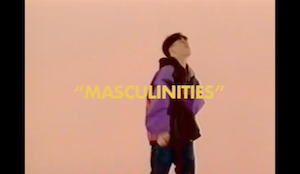MASCULINITIES. THE DOCUMENTARY ABOUT WHAT A MAN IS
MASCULINITIES IS THE NEW VERSION OF PASOLINI'S LOVE MEETINGS
“Masculinities” is a playful, pastel-hued, talking heads film exploring gender roles, patriarchy and hegemonic masculinity. The editorial is presented by NOWNESS, a movement for creative excellence in storytelling celebrating the extraordinary of everyday. The movie is shown at the Barbican, the modern-art centre in London, for the temporary exhibition “Masculinities: Liberation though Photography” (already written here).
If Pier Paolo Pasolini was still alive, he would be for sure the director. In fact, the documentary seems to be the new version of his masterpiece “Love meetings” (1964), where the Italian intellectual asked to people questions about love, stereotypes and “deviant behaviours”.
Here, “Masculinities” brings together members of the British Public with Nowness’s creative community to deconstruct gender identity in its myriad forms. The cast includes gender fluid designer Harris Reed, choreographer Ivan Blackstock, poet Julian Know, and photographer and filmmaker Campbell Andy. The audience cannot recognize who is who and everyone has the same importance and voice, the museum’s director and the child. In this way, they are like samples to represent the universal idea about what man and masculinity are nowadays.
A DIALOGUE ABOUT GENDER, MASCULINITY AND NOWADAYS
The very first question the director asks, is: What is your gender? Apparently seems a very easy question, but not always the gender coincides with the biological sex. Who you are, if not a female or a male? Does a correct label exist?
I’m gender undecided. I’m not comfortable being a man, necessarily. Yes, it’s been a long journey and certainly not over and as time has gone on, I realized I’ve actually rejected a lot of my masculine privilege. I like gender undecided because I haven’t made a decision.
If someone doesn’t recognize as a female or asmale, does it mean that the gender is not binary? Despite some evidences, most of the interviewees think that you are probably one or the other. Male or female. Considering them as some samples for the society, it suggests that transgenders and other non-binary people are still not part of the community. What do you think if you saw a boy on the street wearing a dress? The director asked this to a child and to a straight man. The first one said that: I would think it’s totally … normal because they can wear what they want. There is even a book called “The boy in the Dress”. While the second one admits that he has privileges as a heterosexual male which other people might not have. Every year at carnival many straight men dress up like women only to have a funny day, but it’s important to keep in mind there are men that identify themselves only with female clothes and this doesn’t mean they are less male than others. So, what does masculinity mean? If you ask, like my parents, they’d probably say sort of the mainstream: muscles, beard, good with their hands- that sort of shit but I think it’s just yourself.
Many men feel oppressed from the concept of masculinity, they have to be muscled, beard … to be accepted from the society as (real/good) men. So, the director goes on asking to his samples: How do you define toxic masculinity? Basically, what emerges is that toxic masculinity is: when you enforce your idea of what being a man is and what masculinity is on other people. Times are changing. Thanks to the new media, every day we see more and more and this help us to realize how wide and inclusive is the concept of masculinity can be nowadays. So, the last question, is: How do you think masculinity is changing?
I think like it’s changing in a way which is, like, there’s a lot of more voices. Listen to the kids, listen to the youth because I think the youth have got something really interesting to say.
Just be yourself



Commenti
Posta un commento